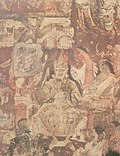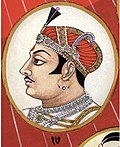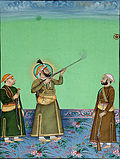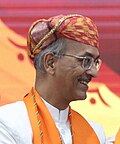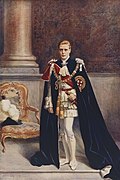This article is a list of the various dynasties and monarchs that have ruled in the Indian subcontinent and it is one of several lists of incumbents.
Contents
- Vedic India (c. 2000s – 200s BCE)
- Kingdom of Magadha
- Kingdom of Kashmir
- Gandhara Kingdom (c. 1500 – 518 BCE)
- Kuru Kingdom (c. 1200 – 345 BCE)
- Kingdom of Avanti (c. 1100 – 400 BCE)
- Videha (c. 1100 – 700 BCE)
- Kalinga Kingdom (c. 1100 – 261 BCE)
- Kosala Kingdom (c. 1100 – 345 BCE)
- Panchala Kingdom (c. 1100 BCE – 350 CE)
- Anga Kingdom (c. 1100 – 530 BCE)
- Kamboja Kingdom (c. 700 – 200 BCE)
- Shakya Republic (c. 7th to 5th century BCE)
- Kingdom of Tambapanni (c. 543 – 437 BCE)
- Ancient and early medieval Southern Indian dynasties
- Pandya dynasty (c. 600 BCE–1650 CE)
- Chera dynasty (c. 600 BCE–1530 CE)
- Chola dynasty (c. 600 BCE–1279 CE)
- Velir dynasties (c. 300 BCE–1200 CE)
- Ay dynasty (Velir) (c. 300 BCE–800 CE)
- Pallava dynasty (c. 275 – 897 CE)
- Kadamba dynasties (c. 345–1310 CE)
- Chutu dynasty of Banavasi (c. 100 BCE–200 CE)
- Vishnukundina dynasty of Denduluru (c. 420–624 CE)
- Chalukya dynasty (c. 500–1200 CE)
- Middle Kingdoms (c. 250s BCE – 550s CE)
- Satavahana dynasty (c. 228 BCE – 224 CE)
- Mahameghavahana dynasty of Kalinga (c. 225 BCE – 300 CE)
- Kingdom of Kangleipak (Manipur) (c. 200s BCE –1950 CE)
- Kuninda Kingdom (c. 2nd century BCE to 3rd century CE)
- Indo-Greek Kingdom (Yavanarajya) (c. 200 BCE – 10 CE)
- Indo-Scythian (Saka) ( c. 12 BCE – 395 CE)
- Kushan dynasty (c. 1 – 375 CE)
- Indo-Parthian (Pahalava) (c. 21 – 100 CE)
- Indo-Sasanian Kingdom (c. 233 – 365 CE)
- Alchon Huns (Huna) (c. 400 – 670 CE)
- Chutu dynasty of Banavasi (c. 100 BCE–200 CE) 2
- Khokhra (Nagvanshi) chieftaincy (c. 64–1952 CE)
- Naga Kingdom of Padmavati (c. 170–350 CE)
- Chandra dynasty of Samatata (c. 202–1050 CE)
- Kingdom of Abhira (c. 203–370 CE)
- Principality of Khoh (c. 221–1028 CE)
- Second Magadha Empire (c. 240 – 750 CE)
- Vakataka dynasty (c. 250–500 CE)
- Aulikara Kingdom of Malwa (c. 300 – 550 CE)
- Kingdom of Kamarupa (c. 350–650 CE)
- Western Ganga of Talakad (c. 350–1424 CE)
- Eastern Ganga of Kalinga (c. 493-1947 CE)
- Traikutaka dynasty of Aparanta (c. 370–520 CE)
- Maitraka dynasty of Vallabhi (c. 475–776 CE)
- Rai Kingdom of Sindh (c. 489–632 CE)
- Kabul Shahi Kingdom (c. 500–1026 CE)
- Pushyabhuti/Vardhan dynasty (c. 500 – 647 CE)
- Jaintia Kingdom (c. 525–1835 CE)
- Early Medieval Period (c. 550s CE – c. 1200s CE)
- Gauda Kingdom (c. 590 – 626 CE)
- Pala dynasty of Bengal (c. 750 – 1174 CE)
- Kalachuri dynasties (c. 550 – 1225 CE)
- Patola/Gilgit Shahi dynasty (c. 550 – 750 CE)
- Gurjara-Pratihara Empire (c. 550 – 1036 CE)
- Chahamana (Chauhan) dynasties (c. 551 – 1315 CE)
- Kingdom of Mewar (c. 566 – 1947 CE)
- Karkota dynasty of Kashmir (c. 625–855 CE)
- Chacha dynasty of Sindh (c. 632–724 CE)
- Mlechchha dynasty of Kamarupa (650–900 CE)
- Garhwal Kingdom (c. 688–1949 CE)
- Mallabhum (Bishnupur) kingdom (c. 694–1947 CE)
- Chand Kingdom of Kumaon (700–1790 CE)
- Karttikeyapur (Katyur) Kingdom (700–1065 CE)
- Varman dynasty of Kannauj (c. 725–770 CE)
- Rashtrakuta Empire (c. 753–982 CE)
- Tomar dynasty of Delhi (c. 736–1151 CE)
- Shilahara dynasty (765–1265 CE)
- Ayudha dynasty of Kannauj (c. 770–810 CE)
- Chandela dynasty of Jejakabhukti (c. 831–1315 CE)
- Seuna (Yadava) dynasty of Devagiri (c. 850–1334 CE)
- Paramara dynasty of Malwa (c. 9th century to 1305 CE)
- Utpala dynasty of Kashmir (c. 855 – 1009 CE)
- Somavamshi dynasty (c. 882 – 1110 CE)
- Pala dynasty of Kamarupa (c. 900 – 1100 CE)
- Paramara dynasty of Chandravati (Abu) (c. 910 – 1220 CE)
- Kingdom of Ladakh (c. 930 – 1842 CE)
- Solanki dynasty (Chaulukyas of Gujarat) (c. 940–1244 CE)
- Kachchhapaghata dynasty (c. 950–1150 CE)
- Kachwaha dynasty (c. 966–1949 CE)
- Hoysala Empire (c. 1000–1343 CE)
- Lohara dynasty of Kashmir (c. 1003–1320 CE)
- Khasa Malla Kingdom (c. 10th to 14th century CE)
- Naga dynasty of Kalahandi (1005 – 1947 CE)
- Sena dynasty of Bengal (1070 – 1230 CE)
- Kakatiya dynasty (1083–1323)
- Gahadavala dynasty (1072–1237)
- Karnata dynasty of Mithila (1097 – 1324 CE)
- Chutia (Sadiya) Kingdom of Assam (1187–1524 CE)
- Late Medieval Period (c. 1200s CE – c. 1500s CE)
- Delhi Sultanate (c. 1206–1526 CE)
- Kadava dynasty (c. 1216–1279 CE)
- Kingdom of Marwar (c. 1226–1950 CE)
- Ahom dynasty of Assam (c. 1228–1826 CE)
- Vaghela dynasty (1244–1304 CE)
- Jaffna (Aryachakravarti) dynasty (c. 1277–1619 CE)
- Kingdom of Tripura (c. 1280–1949 CE)
- Nayaka Kingdoms (c. 1325–1815 CE)
- Reddy Kingdom (c. 1325–1448 CE)
- Oiniwar (Sugauna) dynasty of Mithila (c. 1325–1526 CE)
- Vijayanagara Empire (c. 1336–1646 CE)
- Bahmani Sultanate (c. 1347–1527 CE)
- Malwa Sultanate (c. 1392–1562 CE)
- Baro-Bhuyan kingdoms (c. 1365–1632 CE)
- Tomara dynasty of Gwalior (c. 1375–1523 CE)
- Wadiyar Kingdom of Mysore (c. 1399–1950 CE)
- Gajapati Empire (c. 1434–1541 CE)
- Rathore dynasty of Bikaner (c. 1465–1947 CE)
- Deccan Sultanates (c. 1490–1686 CE)
- Gatti Mudalis of Taramangalam (c. 15th–17th century CE)
- Early Modern Period (c. 1500s CE – 1850s CE)
- Kingdom of Cochin (c. 1503–1948 CE)
- Koch Kingdom (c. 1515–1949 CE)
- Mughal Empire (c. 1526–1857 CE)
- Sur Empire (c. 1540–1555 CE)
- Gajapati of Odisha
- Khurda Kingdom
- Kingdom of Sikkim (c. 1642–1975 CE)
- Maratha Empire (c. 1674–1818 CE)
- Sinsinwar Jat Kingdom of Bharatpur and Deeg (c. 1683–1947 CE)
- Pudukkottai Kingdom (c. 1686–1948 CE)
- Sivaganga Kingdom (c. 1725–1947 CE)
- Kingdom of Travancore (c. 1729–1949 CE)
- Newalkar dynasty of Jhansi (c. 1769–1858 CE)
- Phulkian Dynasty of Punjab (c. 1763–1947)
- Sikh Empire (c. 1801–1849 CE)
- Smaller Muslim polities
- Dogra dynasty of Kashmir and Jammu (c. 1846–1952 CE)
- Modern India (c. 1850s onwards)
- Indian Empire (1858–1947 CE)
- Dominion of India (1947–1950 CE)
- See also
- Other lists of monarchs
- Notes
- References
- Books

The earliest Indian rulers are known from epigraphical sources found in archeological inscriptions on Ashokan edicts [1] [2] written in Pali language and using brahmi script. They are also known from the literary sources like Sanskrit literature, Jain literature and Buddhist literature in context of literary sources. Archaeological sources include archeological remains in Indian subcontinent which give many details about earlier kingdoms, monarchs, and their interactions with each other.
Early types of historic documentation include metal coins with an indication of the ruler, or at least the dynasty, at the time. These Punch-marked coins were issued around 600s BCE and are found in abundance from the Maurya Empire in 300s BCE. There are also stone inscriptions and documentary records from foreign cultures from around this time. The main imperial or quasi-imperial rulers of North India are fairly clear from this point on, but many local rulers, and the situation in the Deccan and South India has less clear stone inscriptions from early centuries. Main sources of South Indian history is Sangam Literature dated from 300s BCE. Time period of ancient Indian rulers is speculative, or at least uncertain.
